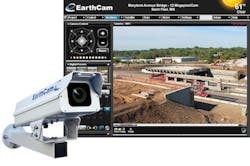Minnesota bridge deck replacement becomes community event
More than 40,000 people watched via webcams as the Minnesota Department of Transportation (MnDOT) demonstrated its first use of accelerated bridge construction techniques to move the new Maryland Avenue Bridge—spanning Interstate 35E in St. Paul, Minn.—into place.
Over the course of a few hours, contractors used self-propelled modular transporters (SPMTs) to move two 1,300-ton, 105-ft prefabricated concrete spans (east- and westbound) about 1,000 ft into position above the interstate. Specially designed megapixel construction cameras by EarthCam, along with multiple other on-site cameras, recorded the entire process.
“We knew the bridge move and the SPMTs would draw the interest of many people in the area,” said Todd Kramascz, director of communications/public affairs for MnDOT’s Metropolitan District. “These SPMTs are enormous. Unfortunately, there is very little physical space around the site to accommodate visitors. So we put together a plan to install multiple video cameras at the site in different locations that would combine to give viewers a really close, almost interactive perspective of the move and a sense that they were a part of the process.”
An EarthCam MegapixelCam camera was mounted to a 50-ft pole located on the east side of the Maryland Avenue/I-35E interchange. This served as MnDOT’s primary record of activities at the site. Additionally, MnDOT’s videographer was on site recording the move from the ground level, while a nearby traffic-management camera provided a slightly different perspective. Another portable camera was mounted to the moving bridge’s deck.
Each bridge deck required several hours to move into place. I-35E reopened to traffic later in the day, and Maryland Avenue crossing the freeway opened little more than three weeks later.
“Accelerated bridge construction techniques allowed us to reduce the overall length of the Maryland Avenue closure to a mere 60 days and gave residents an unexpected feel for the innovative engineering and construction processes that go into bridge work,” said Kramascz said.
The move is available for replay at this website.
